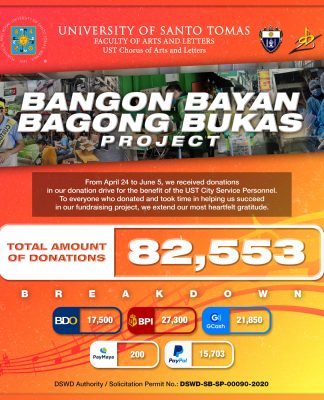ONE PLUS one? Simple enough right? But how about the square of the logarithm of one billion divided by three cubes minus one?
Not a few students would probably scratch their head at the question, if not avoid it like a plague.
No matter how hard students try to dodge Mathematics, the truth of the matter is that Math is already a part of our daily lives. Sooner or later, Thomasians will have to face this subject, whatever their course is.
Understandably, it’s hard to imagine that there are select students walking among us who simply breeze through these equations as if by magic.
One “math wizard” is Jacky Belleza, Mathematics junior from the College of Science. He first got hold of a calculator at age seven, and that’s when he began his love story with numbers.
Since then, he has been joining math competitions and training session conducted by the Mathematics Teachers Association of the Philippines (MTAP).
His efforts eventually paid off when he won first place in the senior division of an interschool math contest.
But for Belleza, it’s not hard work only that bagged his victory but rather his hunger for knowledge.
“Along with my passion for the subject (math), my thirst for knowledge motivated me to learn more,” he said.
Accountancy junior Natalie Lao is also into numbers. She particularly likes short formulas to go around difficult math problems. She’s a mainstay in interschool competitions, including the Pautakan quiz contest.
“I always try to solve math problems using shortcuts,” she said. “Knowing the formula helps because it is easy to derive another formula which is easier to use.”
Mathematical society president Miguel Agbulos agrees, noting that students need not memorize a lot of formulas since they could do away with a simple derivation.
Contrary to the usual practice of students of aiming for the correct answer, Agbulos believes that the solution to a Math problem should be the first problem, rather than the answer.
“It is important to get the answers correctly, but what’s the use if you cannot master the technique of getting the solutions?” Agbulos said.
True enough, Agbulos got 92 out of 100 points in Math aptitude test when he took the UST Entrance Test in 2005. He also constantly registers grades not lower than 90 in his Math units.
“There are many ways to arrive at the correct answer. It will depend on your knowledge of going through the math problem,” he said.
In a study by the National Center for Education Statistics of the United States, the Philippines used to rank 23rd out of 25 top countries that reached standards of mathematical competency by the Trends in International Mathematics and Science Study (TIMSS). In 2008, however, Philippines bombed out of the list.
Consuelo Gotauco, the Math, Science, and Computer coordinator of the Faculty of Arts Letters, said the poor showing could be blamed on the students’ general lack of interest to learn Math the hard way by memorizing formulas and instead resorting to taking the easy way by using calculators and computers.
“Students nowadays solely depend on these things, which in effect diminishes the competencies needed for Math subjects,” Gotauco told the Varsitarian.
Maria Carlota Decena, head of Mathematics and Physics Department at the College of Science, also emphasized “lack of interest” among students as an offshoot to the poor attitude towards Math.
“The students in our college, specifically the non-Math majors, think that math is not important because it is not their core subject,” Decena said.
But apart from this, she said students with poor English skills might also have a hard time with Math, since the analysis of a problem would depend on how students understood the problem.
“If they are poor in English or reading comprehension, they will not be able to see the whole picture and be able to translate it in mathematical concept,” said Decena.
“In math exams one will get either the right or wrong answer, unlike in essay type of exam where the answer is open to argument.” Gotauco said.
Bad impressions and an almost “traumatic” attitude toward Math can be dispelled by the manner of delivery of the Math professors. Gotauco said that it’s actually on the treatment and teaching methods of the teacher that will make Math a more fun learning experience, which will also affect the students’ comprehension.
“When the students get to appreciate the application of Math in their lives, then that is the time that they will say that Math is not that difficult,” she said.
In addition, Gotauco said that in the world of Math those who survive are not really the talented ones but those with the best attitude adding that students should practice as much as they can and pretty soon they will get the hang of it.
“As long as they practice, they should be able to comprehend the concepts of math,” Decena agreed.
If you give importance in understanding the concept of logarithm, square and cube roots, and other math terms, you’ll realize that you don’t need to crack your brain in solving the equation above because the answer to it is as easy as one plus one. Andrewly A. Agaton and Robin G. Padilla















